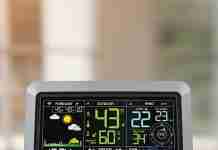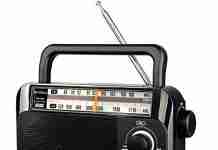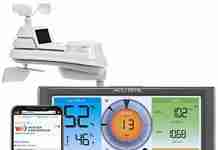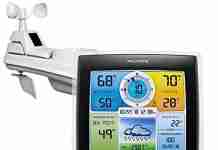If you’re a proud owner of a home weather station, then you’re likely no stranger to the importance of accurate weather data. However, to ensure your sensors are functioning optimally and providing you with reliable information, proper cleaning is essential. In our article, we will guide you through the process of safely cleaning the sensors on your home weather station, allowing you to maintain accurate readings and continue enjoying the benefits of your weather tracking device.
Review contents
Understanding the importance of cleaning weather station sensors
Weather stations are invaluable tools that provide us with accurate information about the weather conditions in our local area. They rely on sensors to collect data and measure various parameters such as temperature, humidity, barometric pressure, wind speed and direction, rainfall, UV index, and solar radiation. These sensors play a crucial role in accurately assessing and predicting the weather, making it imperative to keep them clean and well-maintained.
The role of sensors in a home weather station
Sensors are the heart of any home weather station, as they are responsible for capturing and measuring the different weather elements. These sensors are typically located in a separate housing, also known as a sensor suite, which is placed outdoors to gather data from the surrounding environment. They communicate with the main unit of the weather station, relaying the information for display and analysis.
The effects of dirt and debris on sensor accuracy
Dirt and debris can significantly impact the accuracy of the sensors in a home weather station. When sensors become dirty, they may provide inaccurate readings or even fail to function altogether. For example, if the temperature sensor is covered in dust or grime, it may register a higher or lower temperature than what is actually present. Similarly, if the rain gauge sensor is obstructed by debris, it may not accurately measure rainfall, leading to erroneous data.
Regular cleaning of the sensors is necessary to ensure that they continue to provide reliable and precise measurements. Neglecting this maintenance task can result in skewed data and compromised functionality, ultimately undermining the usefulness of the weather station.
Regular cleaning as a maintenance practice
Cleaning weather station sensors should be incorporated into your regular maintenance routine to ensure optimal performance. While the frequency of cleaning will depend on various factors such as local weather conditions and the level of airborne pollutants in your area, it is generally recommended to clean the sensors at least once every few months or whenever you notice a significant build-up of dirt or debris.
By making sensor cleaning a regular practice, you can prevent potential issues caused by dirty sensors and maintain the accuracy of your weather station. Additionally, this maintenance task allows you to inspect the sensors for any signs of damage or wear, enabling you to address any issues promptly.
Identifying the different types of sensors in a home weather station
A home weather station typically consists of several sensors that are designed to measure different weather parameters. Understanding the functions of each sensor is essential for effective cleaning and maintenance. Here are the most common types of sensors found in home weather stations:
Temperature sensor
The temperature sensor measures the ambient temperature in your area. It is usually housed in an enclosure and placed in a location that ensures accurate readings, away from direct sunlight or sources of heat.
Humidity sensor
The humidity sensor measures the moisture content in the air. It is crucial for assessing the comfort level and predicting precipitation. Like the temperature sensor, the humidity sensor is usually placed in a sheltered location to prevent interference from direct sunlight or external factors.
Barometric pressure sensor
The barometric pressure sensor measures the atmospheric pressure, which is essential for understanding changes in weather patterns. It helps identify trends and predict forthcoming weather conditions. The barometric pressure sensor is typically housed in a sealed enclosure to ensure accurate readings.
Anemometer (wind speed and direction) sensor
The anemometer measures wind speed and direction. It consists of rotating cups or vanes that capture the wind’s force and movement. This sensor is usually mounted on a pole or rooftop to offer an unobstructed view of the surrounding environment.
Rain gauge sensor
The rain gauge sensor measures the amount of rainfall over a given period. It typically consists of a funnel-like collector that directs rainwater into a measurement chamber. The rain gauge sensor should be positioned in an open area to receive accurate rainfall data.
UV index sensor
The UV index sensor measures the intensity of ultraviolet (UV) radiation from the sun. It is important for assessing the potential risk of sunburn and determining the appropriate sun protection measures. The UV index sensor is typically located in an exposed position to measure direct sunlight accurately.
Solar radiation sensor
The solar radiation sensor measures the amount of solar energy reaching the surface of the Earth. It helps in understanding the amount of sunlight available for various purposes, such as solar power generation. The solar radiation sensor is usually positioned in an area that receives direct sunlight throughout the day.
Determining the cleaning requirements for each sensor type
Cleaning the sensors in your home weather station involves different techniques tailored to each sensor type. Here are some guidelines for cleaning each sensor effectively:
Temperature sensor cleaning
The temperature sensor is relatively simple to clean. Start by identifying the location of the sensor within the sensor suite. Use a soft microfiber cloth or lens cleaning wipes to gently wipe the sensor’s surface. If there are hard-to-reach areas, you can use a cotton swab or soft brush to carefully clean them. Avoid using excessive force to prevent damage to the sensor.
Humidity sensor cleaning
To clean the humidity sensor, locate its position within the weather station. Use a slightly damp soft cloth or lens cleaning wipes to wipe the sensor gently. Take care not to wet the sensor excessively, as this can affect its performance. Avoid using liquids that contain harsh chemicals, as these may damage the sensor.
Barometric pressure sensor cleaning
Locate the barometric pressure sensor within the weather station. Use a soft cloth or lens cleaning wipes to remove any dirt or dust that may have accumulated on the sensor’s surface. If needed, use a cotton swab or soft brush for more intricate cleaning. Be gentle and avoid applying excessive pressure, as it may damage the sensor.
Anemometer sensor cleaning
Identify the anemometer sensor on your weather station. Begin by wiping away any visible dirt or debris with a soft cloth or brush. For hard-to-reach areas, you can use compressed air or a blower to remove any remaining particles. Take care not to damage the delicate components while cleaning.
Rain gauge sensor cleaning
To clean the rain gauge sensor, start by removing any visible dirt or debris from the collector using a soft cloth or brush. Next, use a mild detergent or sensor-specific cleaning solution diluted with distilled or filtered water to clean the collector thoroughly. Rinse off the cleaning solution with clean water and pat dry.
UV index sensor cleaning
Identify the UV index sensor in your weather station. Clean the sensor by wiping it gently with a soft cloth or lens cleaning wipes. Avoid using harsh chemicals or excessive moisture, as these can negatively impact the sensor’s performance. Ensure that the sensor is dry before reassembling.
Solar radiation sensor cleaning
Cleaning the solar radiation sensor involves gently wiping the sensor’s surface with a soft cloth or lens cleaning wipes. Avoid using abrasive materials or cleaning agents that may scratch or damage the sensor. Ensure that the sensor is clean and dry before reassembling.
Preparing the necessary tools and materials for sensor cleaning
Before you begin cleaning the sensors, gather the following tools and materials to ensure a safe and effective cleaning process:
- Soft microfiber cloth or lens cleaning wipes: These are essential for wiping the sensors without scratching or damaging them.
- Cotton swabs or soft brushes: These can help clean hard-to-reach areas or intricate parts of the sensors.
- Mild detergent or sensor-specific cleaning solution: Dilute it with distilled or filtered water for cleaning the rain gauge sensor or any other sensor that requires deeper cleaning.
- Distilled or filtered water: Use it for rinsing or diluting cleaning solutions.
- Compressed air or blower: These tools are useful for removing dirt and debris from hard-to-reach areas, such as the anemometer sensor.
- Rubbing alcohol (Isopropyl alcohol): This can be used sparingly on a cloth or swab for sanitizing purposes, if recommended by the manufacturer.
Having these tools and materials readily available will make the cleaning process more efficient and ensure that you have everything you need for each specific sensor.
General guidelines for cleaning weather station sensors
While the specific cleaning requirements may vary for each sensor type, there are some general guidelines that apply to cleaning weather station sensors:
Read the manufacturer’s instructions
Before cleaning any sensor, it is important to read and follow the manufacturer’s instructions. These guidelines will provide specific information on how to clean and maintain each sensor properly. Following the manufacturer’s instructions will help ensure that you do not inadvertently damage the sensors or void any warranties.
Switch off the weather station and disconnect power
Safety should always be a priority when cleaning weather station sensors. Before you begin the cleaning process, switch off the weather station and disconnect it from any power sources. This minimizes the risk of electrical shock and protects both you and the equipment.
Remove the sensor covers or enclosures
To access the sensors, you will usually need to remove the sensor covers or enclosures. These covers are designed to protect the sensors from weather elements, so removing them allows for a thorough cleaning. Follow the manufacturer’s instructions on how to safely remove the covers without causing any damage.
Gently remove loose dirt and debris
Before using any cleaning tools or solutions, gently remove any loose dirt or debris from the sensor’s surface. This can be done by lightly brushing or wiping the sensor with a soft cloth. Taking this step helps prevent scratching the sensors during the cleaning process.
Using the appropriate cleaning tool for each sensor type
Different sensors may require specific cleaning tools or techniques. Refer to the guidelines provided earlier for each sensor type to determine the most suitable cleaning method. Remember to be gentle and avoid using excessive force, as the sensors are sensitive and delicate.
Avoid excessive moisture or harsh chemicals
While some sensors may tolerate mild moisture, it is generally best to avoid wetting the sensors excessively during the cleaning process. Use a damp cloth or lens cleaning wipes sparingly, ensuring that you do not saturate the sensors. Additionally, harsh chemicals should be avoided, as they can damage the sensors. Stick to mild detergents or sensor-specific cleaning solutions, if necessary.
Dry the sensors and reassemble
After cleaning each sensor, ensure that it is completely dry before reassembling the weather station. Excess moisture can interfere with the sensors’ functionality and cause corrosion over time. Once the sensors are dry, carefully reattach the sensor covers or enclosures, following the manufacturer’s instructions.
Cleaning the temperature sensor
The temperature sensor is a crucial component of any home weather station, as it provides accurate temperature readings. To clean the temperature sensor effectively, follow these steps:
Identify the location of the temperature sensor
Refer to the manufacturer’s instructions or documentation to determine the exact location of the temperature sensor within your weather station. Most weather stations will have the temperature sensor located within the sensor suite.
Gently wipe the sensor with a soft cloth or lens cleaning wipes
Using a soft microfiber cloth or lens cleaning wipes, gently wipe the temperature sensor’s surface. This will remove any dust or dirt that may have accumulated on the sensor. Be careful not to exert excessive pressure or use rough materials that could scratch the sensor.
If necessary, use a cotton swab or soft brush for hard-to-reach areas
If there are hard-to-reach areas on the temperature sensor, you can use a cotton swab or soft brush to clean them gently. Take caution not to push any debris into the sensor or damage any delicate components. The goal is to remove any dirt or dust without interfering with the sensor’s performance.
Cleaning the humidity sensor
The humidity sensor is responsible for measuring the moisture content in the air. To clean the humidity sensor safely, follow these steps:
Locate the humidity sensor in the weather station
Refer to the manufacturer’s instructions or documentation to determine the location of the humidity sensor within your weather station. The humidity sensor is typically located within the sensor suite, along with the other sensors.
Wipe the sensor gently with a slightly damp cloth or lens cleaning wipes
Using a slightly damp soft cloth or lens cleaning wipes, gently wipe the humidity sensor’s surface. This will remove any grime or dirt that may have accumulated on the sensor. Take care not to wet the sensor excessively, as this can affect its accuracy and functionality.
Avoid wetting the sensor excessively
While it is important to clean the humidity sensor, excessive moisture can interfere with its performance. Make sure to avoid using excessive water or cleaning agents that contain harsh chemicals. Stick to using a damp cloth or lens cleaning wipes sparingly and allow the sensor to dry thoroughly before reassembling.
Cleaning the barometric pressure sensor
The barometric pressure sensor measures atmospheric pressure and plays a significant role in weather prediction. To clean the barometric pressure sensor safely, follow these steps:
Locate the barometric pressure sensor
Refer to the manufacturer’s instructions to identify the location of the barometric pressure sensor within your weather station. The sensor is typically housed within the sensor suite, along with the other sensors.
Use a soft cloth or lens cleaning wipes to remove dirt and dust
Gently wipe the surface of the barometric pressure sensor using a soft cloth or lens cleaning wipes. This will help remove any dirt or dust that may have accumulated on the sensor. Take care not to exert excessive pressure or use materials that may scratch or damage the sensor.
If needed, a cotton swab or soft brush can be used for more intricate cleaning
If there are intricate parts or hard-to-reach areas on the barometric pressure sensor, you can use a cotton swab or soft brush to clean them gently. Be sure to exercise caution and avoid pushing any debris into the sensor or causing any damage. The goal is to remove any dirt or dust without affecting the sensor’s accuracy.
Cleaning the anemometer sensor
The anemometer sensor is responsible for measuring wind speed and direction. To clean the anemometer sensor effectively, follow these steps:
Identify the anemometer sensor on the weather station
Consult the manufacturer’s instructions or documentation to locate the anemometer sensor within your weather station. It is typically mounted on a pole or rooftop for accurate wind measurements.
Remove any visible dirt or debris by wiping with a soft cloth or brush
Begin by wiping away any visible dirt or debris on the anemometer sensor’s surface using a soft cloth or brush. This will help remove loose particles that could interfere with its functionality.
Use compressed air or blower for hard-to-reach areas
For hard-to-reach areas or areas where dirt and debris may be more stubborn, using compressed air or a blower can help dislodge it. Direct the airflow carefully to avoid damaging any delicate components of the anemometer sensor. Clean the surrounding area to prevent the dislodged debris from resettling on the sensor.
Additional tips and precautions for sensor cleaning
In addition to the specific cleaning guidelines provided for each sensor type, here are some additional tips and precautions to keep in mind:
Avoid using abrasive materials or cleaning agents
When cleaning weather station sensors, it is crucial to avoid using abrasive materials, such as rough cloth or harsh scrub brushes, as they can scratch or damage the sensors. Similarly, it is important to refrain from using cleaning agents that contain harsh chemicals, as these may corrode or degrade the sensors.
Do not submerge any part of the weather station in water
Submerging any part of the weather station, including the sensor suite, in water can cause irreversible damage to the electronic components. Always prioritize using damp cloths, soft brushes, or other cleaning tools that minimize the risk of introducing excess moisture to the sensors.
Always refer to the manufacturer’s guidelines for specific cleaning recommendations
The manufacturer’s instructions and guidelines should always be your primary source of information when it comes to cleaning weather station sensors. These guidelines are tailored to the specific design and requirements of your weather station, ensuring that you clean the sensors safely and effectively.
Regularly inspect the sensors for any signs of damage or wear
While cleaning the sensors, it is important to take the opportunity to inspect them for any signs of damage or wear. Look out for cracks, corrosion, loose connections, or other issues that may affect their performance. If you notice any problems, consult the manufacturer’s guidelines or consider seeking professional maintenance services.
Consider professional maintenance services for complex repairs or extensive cleaning needs
If you encounter complex issues with your weather station sensors or require extensive cleaning beyond what can be done with basic maintenance, it may be advisable to seek professional maintenance services. Professionals with expertise in weather station equipment can diagnose and address any underlying problems, ensuring that your weather station performs optimally.
Regular cleaning and maintenance of weather station sensors are essential for accurate and reliable weather data. By understanding the different types of sensors, their cleaning requirements, and following proper cleaning techniques, you can ensure that your home weather station continues to provide accurate weather information year after year. Taking the time to care for these sensors will help you maximize the value of your weather station and make the most informed decisions regarding weather-related activities.



































